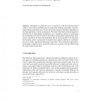Free Online Productivity Tools
i2Speak
i2Symbol
i2OCR
iTex2Img
iWeb2Print
iWeb2Shot
i2Type
iPdf2Split
iPdf2Merge
i2Bopomofo
i2Arabic
i2Style
i2Image
i2PDF
iLatex2Rtf
Sci2ools
NICSO
2010
Springer
2010
Springer
A Metabolic Subsumption Architecture for Cooperative Control of the e-Puck
Subsumption architectures are a well-known model for behaviour-based robotic control. The overall behaviour is achieved by defining a hierarchy of increasingly sophisticated behaviours. We are interested in using evolutionary algorithms to develop appropriate control architectures. We observe that the layered arrangement of behaviours in subsumption architectures are a significant obstacle to automating the development of control systems. We propose an alternative subsumption architecture inspired by the bacterial metabolism, that is more amenable to evolutionary development, where communities of simple reactive agents combine in a stochastic process to confer appropriate behaviour on the robot. We evaluate this approach by developing a traditional and a metabolic solution to a simple control problem using the e-puck educational robot.
Appropriate Control Architectures | Artificial Intelligence | Behaviour-based Robotic Control | NICSO 2010 | Subsumption Architecture |
| Added | 18 May 2010 |
| Updated | 18 May 2010 |
| Type | Conference |
| Year | 2010 |
| Where | NICSO |
| Authors | Verena Fischer, Simon J. Hickinbotham |
Comments (0)

